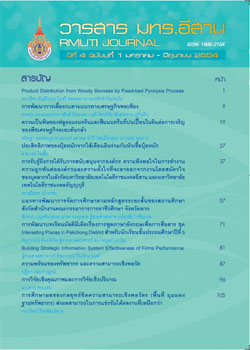การพัฒนาวิธีการเลี้ยงกบตามแนวปรัชญาเศรษฐกิจพอเพียง
Main Article Content
Abstract
บทคัดย่อ
การวิจัยเรื่องพัฒนาวิธีการเลี้ยงกบตามแนวปรัชญาเศรษฐกิจพอเพียง มีวัตถุประสงค์เพื่อ ศึกษาการเจริญ เติบโต อัตราการแลกเนื้อ อัตราการรอดตาย ต้นทุนการผลิตและผลตอบแทนจากการเลี้ยงกบลูกผสม 3 สายเลือด ที่เกิดจากพ่อพันธุ์กบนาแตกต่างกัน 2 สกุล คือ กบนาสกุล tigerina และกบนาหรือเรียกอีกชื่อว่ากบจาน สกล vugulosa ผสมข้ามพันธุ์กับแม่กบ 3 สายเลือดระหว่าง กบนา X กบจาน X กบบูลพ่ร๊อก ด้วยวิธีการเลี้ยงกบในบ่อแตกต่างกัน ปัจจัยในการทดลองมี 2 ปัจจัยได้แก่ (ปัจจัยที่ 1) มี 2 พันธุ์ ได้แก่ กบลูกผสมที่เกิดจากพ่อกบนาและกบลูกผสมที่เกิดจากพ่อกบจาน และวิธีการเลี้ยง ก็คือบ่อเลี้ยง (ปัจจัยที่ 2) มี 5 ชนิด ได้แก่ บ่อซีเมนต์, บ่อกระชัง, บ่อดิน, บ่อหลุม และบ่อคอนโด วางแผนการทดลองแบบ 2x5 of RCBD (2x5 Factorial of Randomized Completely Block Design) แต่ละชุดการทดลองมี 4 ซ้ำ กบเริ่มทดลองมีอายุ 3 วัน มีนํ้าหนักเฉลี่ยเมื่อเริ่มทดลองเท่ากับ 2.63 และ 2.99 กรัมตามลำดับ อัตราการ ปล่อยเลี้ยง 100 ตัว/ตารางเมตร เมื่อสิ้นสุดการทดลอง พบว่า กบลูกผสมจากพ่อกบจานมีการเจริญเติบโต ดีกว่า มีอัตราการแลกเนื้อดีกว่า มีนํ้าหนักเพิ่มเฉลี่ยและอัตราการเจริญเติบโตจำเพาะสูงกว่า มีอัตราการ รอดตายไม่แตกต่างกัน มีจุดคุ้มทุนตํ่ากว่าและให้ผลตอบแทนเป็นกำไรมากกว่ากบลูกผสมจากพ่อกบนา และวิธีการเลี้ยงกบในบ่อซีเมนต์ให้ผลตอบแทนดีที่สุด กบลูกผสมจากพ่อกบจานเลี้ยงในบ่อซีเมนต์เป็น วิธีการเลี้ยงที่ดีที่สุดและให้ผลตอบแทนสูงที่สุด สรุปว่าการเลี้ยงกบลูกผสมที่เกิดจากพ่อกบจานเลี้ยงในบ่อ ซีเมนต์ให้ผลตอบแทนสูงที่สุด แตกต่างจากชุดทดลองอื่นอย่างมีนัยสำคัญทางสถิติ (P<0.05)
Abstract
The development of frog culture method under the sufficiency economy philosophy. The objective of this study was to study of growth performance, feed conversion ratio, survival rate and cost benefit from hybrid - frog rearing and cultural activity The 2x5 factorial in randomized completely block design was usec, consisted of two experiments. The experiment 1 was the comparative study of two breed of frogs including three Bred hybrid frogs (group 1) from Rana tigerina males and three bred cross females (R. tigerina X R. vugulosa Wiegmann X R. catesbeiana) and hybrid frogs (group 2) from R. vugulosa Wiegmann males and three bred cross females (R. tigerina X R. vugulosa Wiegmann X R. catesbeiana). The experiment 2 was the comparative study on frog culture methods under the sufficiency economy philosophy using 5 different types of pond as following; cement ponds, cage ponds, soil ponds, hole ponds and condominium ponds. There were four replications in each group. The results showed that average weight gain, average daily weight gain, specific growth rate, feed conversion rate, incomes and returns of hybrid frogs from R. vugulosa Weigmann tigerina males were significantly higher than of which hybrid frogs form R. tigerina males (p<0.05). The most appropriate method that obtained highest income was cement p ond culture.
Key word : Frog Culture Method, Three Bred Hybrid Frogs, Sufficiency Economy PhilosophyArticle Details

This work is licensed under a Creative Commons Attribution-NonCommercial-NoDerivatives 4.0 International License.


